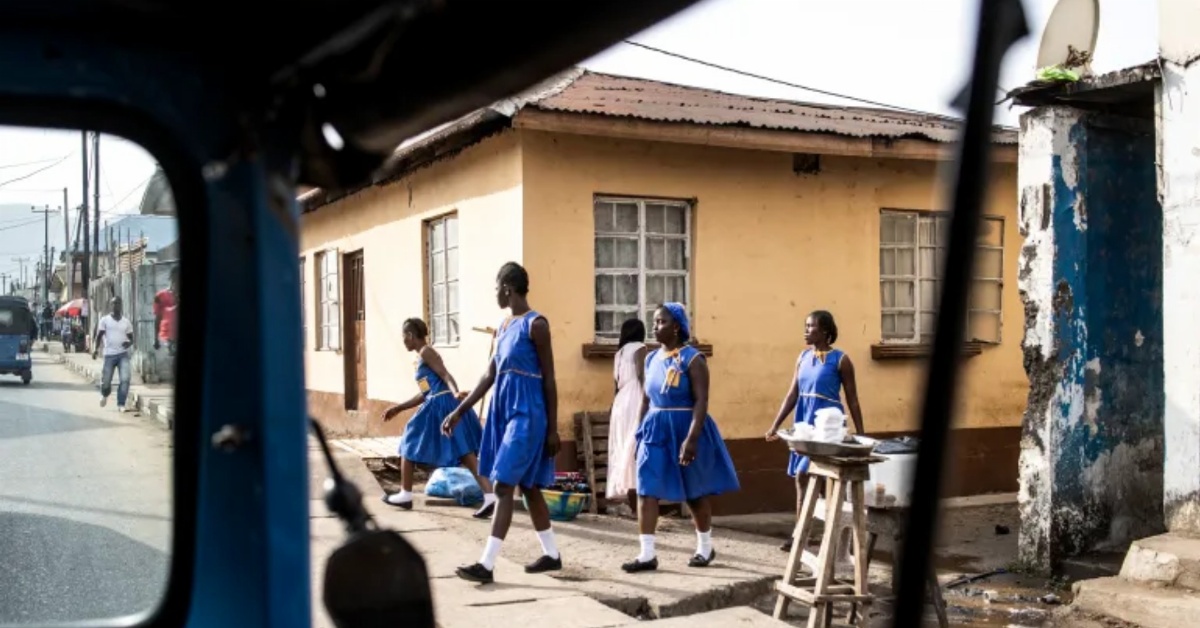Mariamu did not intend to give birth at school. She had discovered she was pregnant, aged 16, during Sierra Leone’s nine-month Ebola lockdown in 2014. Her boyfriend disappeared and she was consumed by shame and despair. She dropped out of school thinking her education was over.
Then, eight months into her pregnancy, her family received a visit from staff at a new “community learning centre” with a remit to enrol pregnant girls and teen mothers. The centre – one of hundreds set up in the wake of Ebola across Sierra Leone – was staffed by specially trained teachers who taught there after their regular classes, using accelerated learning approaches.
This means condensing the regular curriculum into a shorter time frame to help students catch up, focusing on the foundations of literacy and numeracy, alongside social and emotional learning. Mariamu was thrilled to be learning again.
One day in class, she started to feel cramps. The centre’s coordinator took her to her office. Before they could arrange transport to a health centre, her baby boy was born.
Just two weeks after giving birth, both mother and baby were back at the learning centre three days a week. Mariamu was given a space to breastfeed and the centre coordinator looked after her baby while she was in class.
Today, eight years later, Mariamu is in the second year of her college degree course, having reintegrated into formal school and completed her secondary education.
While giving birth in school is rare, Mariamu’s predicament is not. The Ebola epidemic gave us a terrible foretaste of the impact of COVID-19 shutdowns on adolescent girls. Multiple studies around the world have shown how the shutdowns of 2020 and 2021 resulted in heightened levels of gender-based violence, teen pregnancy, child marriage, and child labour. Research in Western Kenya, for example, showed how teenage girls were twice as likely to fall pregnant at this time.
The wide incidence of rape and lack of access to contraception sent pregnancy rates soaring during both COVID-19 and Ebola. A United Nations study showed how Sierra Leone’s teen pregnancy rate surged during the Ebola crisis from 30 to 65 percent, with 14,000 additional pregnancies. In 2020, Save the Children estimated that COVID-19 shutdowns would lead to an additional 23,000 teen pregnancies in the country by the end of the year.
These vulnerable adolescents are the lost girls of COVID-19 – 11 million girls globally who the UN predicted might not return to classes after the pandemic, on top of the 130 million already out of school.
Meanwhile, research from across Africa suggests that it’s older girls, like Mariamu, who are least likely to return now. These girls are among the most marginalised of the marginalised. To get them back, experience shows that we need urgent, purposeful and targeted action: We need what in Sierra Leone is described as “radical inclusion”.
It starts at the grassroots, in the community, where deeply entrenched beliefs and gender norms are often barriers to pregnant girls and young mothers continuing in education. In Sierra Leone, informal learning centres like Mariamu’s conduct intensive outreach with influential community members, including paramount chiefs and local leaders who act as non-partisan members of parliament. They sit with them, listening to their viewpoints and explaining why these girls should continue with their education. The leaders see the value of educating girls and the role they can play in more prosperous families and communities.
It worked. In 2015, with the support of international donors, 14,500 pregnant and breastfeeding girls were enrolled in community learning centres, with 5,000 of these reintegrating into the formal school system in both 2016 and 2017.
Sierra Leone’s COVID-19 response has built on this experience, with dedicated remedial classes in more than 300 community learning centres. Girls have been provided with school bags, shoes, books, writing materials, sanitiser and face masks to cut the costs associated with school. So far this calendar year, the centres have reintegrated more than 800 adolescent girls in four districts into formal schools.
Their ability to reach more has been hampered by financial constraints as international donor support dwindled. Dr Olive Musa, who leads the programme nationally, says much more still needs to be done, especially when it comes to supporting young mothers to generate income to provide for their children. International donor support and coordination across government sectors are critical.
As well as getting girls into school and empowering them to believe in a different future, radical inclusion means addressing the mindsets of men, boys and communities that perpetuate tired stereotypes of what girls can and can’t do. This calls for gender-transformative approaches.
One example is a four-year project that the NGO International Rescue Committee ran in Sierra Leone. As well as education and empowerment activities for girls, it included community dialogues and radio shows that challenged communities’ attitudes to educating adolescent girls. An evaluation showed that this had a significant impact, including through a decline in child marriages.
Supportive legal and policy frameworks are also vital in achieving positive change. Sierra Leone made a start by, in 2020, overturning a ban on pregnant girls and teenage mothers attending school and sitting for exams. This was followed, in 2021, by a Radical Inclusion Policy for the education of historically marginalised groups, including pregnant girls, parent learners, children with disabilities, children from rural and underserved areas, and children from low-income families.
The policy aims to strengthen Sierra Leoneans’ access to free quality basic education for all. These important policies must be complemented by other measures – health services and meals in schools, sexuality education, as well as childcare and income-generating support for girls returning to class after giving birth.
Sierra Leone is also decriminalising abortion to protect young women’s health and choices. Research has shown that 34 percent of pregnancies and 40 percent of maternal deaths in the country are among adolescents.
Finally, to do all this well, governments need robust data that is disaggregated so we can see what’s really happening with different groups of girls, instead of treating them as a homogenous group.
Sierra Leone’s move towards an education system that truly works for everyone is still a work in progress, but we hope the country’s approach of radical inclusion towards girls who have dropped out of school offers valuable lessons for others.
Its example could not only help other nations recover from the ravages of the pandemic, but it could also assist them in building more robust education systems for the 21st century. Mariamu’s story shows what can happen if we get it right.
* Mariamu’s name has been changed to protect her right to privacy.
Credit: Aljazeera



 Post a comment
Post a comment 









